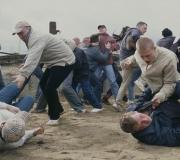Test on Russian history online. Online history tests
What is the "apple of your eye"? Why was it good form for a guest to knock on the door with their feet? What are "laces" and why sharpen them? These and other fun facts are waiting for you in the test!
The 17th century brought many trials to the Russian state. This time is also called “rebellious”. Find out why in this quiz.
During the reign of Alexei Mikhailovich, relative calm reigned in Russia; there were no serious military upheavals. Other educational facts from this period are in this quiz.
The Patriotic War of 1812 was the liberation war of Russia against Napoleonic aggression. Check what you know about this historical event.
Tenth graders, how well do you know the history of your country? Check it out in this test!
Each century in the history of the development of Russian culture is marked by many outstanding creators in different fields of art.
During the years of Soviet power, there was active propaganda of the communist future, which was erected on a cult pedestal. The most striking and widespread example of propaganda of that time are Soviet posters.
The culture of Ancient Rus' had a high level of development. From those times, mainly churches, cathedrals, icons, literature, and religious objects have survived to this day.
The beginning of writing is a special stage in the history of every people, in the development of its culture. Some facts from the history of Slavic writing await you in this test.
Without the discoveries of the great mathematicians of antiquity, we would probably still be using knot counting. Test your knowledge of the history of mathematics in this quiz.
Russia has experienced many wars throughout its history. Test your knowledge of the great battles (on sea and land) of wars of past centuries.
Over time, many concepts are forgotten, things that were once in every home go out of use. But science history remembers all this.
The victory of Russia in the Patriotic War of 1812 is an expression of the unyielding will and boundless determination of the people who rose up in defense of the national independence of their Motherland.
The 19th century was marked by the heyday of Russian painting. The works of Russian artists of that era have unique value and great weight in the world cultural heritage.
1. Russia was proclaimed a republic:
A) September 1, 1917,
B) March 3, 1917,
B) January 10, 1918,
D) December 30, 1922
2. When was the declaration of state sovereignty of the Russian Federation adopted?
A) December 25, 1993,
B) September 1, 1917,
B) June 12, 1990,
D) December 7, 1991.
3. In what year did the Moscow state become completely independent of the Golden Horde?
A) 1375
B) 1503
B) 1110
D) 1480
4. In 1549...
A) the Grand Duke of Moscow Ivan IV the Terrible is crowned king for the first time.
B) the first estate-representative body was convened - the Zemsky Sobor.
C) Moscow finally annexes the Kazan Khanate.
D) the war with Sweden began.
5. Livonian War – the struggle for...
a) beyond the Baltic states and access to the Baltic Sea.
b) for Don;
c) for Ryazan;
d) for access to the Black Sea.
6. Serfdom is….
a) part of the territory of the state, with special administration, allocated for the maintenance of the royal court and guardsmen.
b) historically, this is a system of society where a person is the property of another person.
c) a set of legal norms of the feudal state, which established the most complete and severe form of peasant dependence. or states.
d) collective name for all classes.
7. The Troubles in Russia began:
a) at the beginning of the 15th century;
b) at the beginning of the 16th century;
c) at the beginning of the 17th century
d) at the beginning of the 18th century.
8. The reign of Genghis Khan falls on...
a) 1206-1227
b) 1505 - 1533
c) 1533 - 1584
d) 1180 – 1212
9. On April 5, 1242, the prince ... defeated the crusaders on Lake Peipsi (Battle of the Ice).
a) Ivan III.
b) Alexander Yaroslavich Nevsky.
c) Vasily III Ivanovich.
d) Ivan IV Vasilyevich the Terrible.
10. After the reign of Vasily III Ivanovich, the following ascended to the throne:
a) Ivan III.
b) Alexander Yaroslavich Nevsky.
c) Vasily IV
d) Ivan IV Vasilyevich the Terrible.
11. The reforms of Ivan IV Vasilyevich the Terrible fall on:
a) 1533 - 1584
b) 1547 - 1557
c) 1584 - 1598
d) 1540 – 1551
12. The beginning of the Troubles refers to
a) strengthening of rumors that the legitimate Tsarevich Dmitry was alive, from which it followed that the reign of Boris Godunov was illegal.
b) the people were dissatisfied with the rule of Boris Godunov and tried to remove him.
c) Boris Godunov refused to reign and there was no one to lead the throne.
d) the people thirsted for power.
13. After False Dmitry I, the time of reign came:
a) False Dmitry II;
b) Fyodor Godunov;
c) Vladislav I;
d) Vasily Shuisky;
14. At the Zemsky Council of 1613, the following was elected king:
a) Ivan Vorotynsky,
b) Dmitry Trubetskoy,
c) Dmitry Pozharsky,
d) Mikhail Romanov.
15. The first of the Romanov dynasty was:
a) Alexey Mikhailovich;
b) Mikhail Fedorovich;
c) Kirill Vladimirovich;
d) Vladimir Alexandrovich.
16. The absolutist... becomes a model for power reform for Peter I...
a) Sweden.
b) Germany.
c) France.
d) England.
17. The Russian-Turkish war of 1768-1774 was fought in... (choose the odd one out):
a) Bessarabia.
b) Moldova.
c) in the Caucasus.
d) Armenia.
18. Serfdom was finally established and the indefinite search for fugitive peasants was established:
a) Zemsky Sobor of 1613
b) Zemsky Sobor of 1653
c) The Council Code of 1649
d) The Council Code of 1627
19. The cause of the Russian-Turkish War of 1787-1792 was:
a) Turkey’s desire to regain Crimea.
b) Türkiye felt the support of Austria.
c) Turkey’s reluctance to submit to Russia.
d) Türkiye had a rest from the previous war and was ready for a new battle.
20. In what years was the Peasant War led by Emelyan Pugachev?
a) 1770 – 1773
b) 1773-1775
c) 1771 – 1776
d) 1775 -1778
21. The Russian-Persian War was:
a) 1806-1812
b) 1804-1813
c) 1808-1809
d) 1813 -1814
22. The fourth Russian-Turkish war (1828-1829) was associated with:
a) Turkey’s desire to regain Crimea.
b) the fact that Türkiye felt the support of Austria.
c) Turkey’s reluctance to submit to Russia.
d) Russian support for Greece, which is trying to throw off the Turkish yoke.
23. Which country in the First Eastern War (or Crimean Campaign) 1853-1856. took a position of hostile neutrality:
a) Turkey,
b) England,
c) France,
d) Austria.
24. In what year was serfdom abolished?
a) in 1861
b) in 1864
c) in 1818
d) in 1874
25. To wage the war, Japan received large financial and military assistance from outside (Russian-Japanese War 1904-05)
a) Germany.
b) England.
c) France.
d) Italy.
26. In what year was compulsory free primary education introduced in Russia?
a) 1990
b) 1995
c) 1908
d) 1912
27. In September 1953:
a) Testing of an atomic bomb in the USSR.
b) Election of N.S. as First Secretary of the CPSU Central Committee. Khrushchev.
c) Launch of the world's first artificial Earth satellite in the USSR.
d) Launch of the world's first industrial nuclear power plant in the USSR.
28. In August 1963, in Moscow, an agreement was signed banning the testing of nuclear weapons in the atmosphere, in outer space and under water between:
a) USSR, USA and England.
b) USA, Germany, USSR;
c) the USSR and England;
d) USSR, USA and England.
29. The Constitution of the USSR was adopted:
a) 1920
b) 1956
c) 1977
d) 1981
30. What was not a prerequisite for the formation of a state among the Slavs?
a) The decomposition of the primitive communal system and the emergence of inequality.
b) Selection of the squad and the prince - its head.
c) The development of trade and the emergence of cities.
d) The overthrow of one person in power, and the desire for equality.
31. What is the advantage of industrialization?
a) The economic independence of the country has been achieved;
b) lagging behind in the pace of development of light industry and the consumer sector;
c) famine of 1932-1933. in the southern regions, high mortality (up to 8 million people);
d) violent disruption of the age-old way of life of the majority of the population.
32. What is the advantage of industrialization?
a) violent disruption of the age-old way of life of the majority of the population;
b) a powerful military-industrial complex has been created;
c) over-centralization and nationalization of the economy, strict planning, the final destruction of the self-regulation mechanism of the economy and its replacement with an administrative-command management system;
d) weak material incentives for labor, which resulted in a drop in the standard of living of the population and an increase in psychological tension in society.
33. A totalitarian regime is...
a) a political regime in which the people are recognized as the only source of power, power is exercised according to the will and in the interests of the people. Democratic regimes develop in legal states;
b) the ultimate form of autocracy;
c) a political system characterized by the establishment of state control over all spheres of public life, violence, and the absence of democratic freedoms and individual rights;
d) characterized by complete lack of rights for subjects, brutal suppression of any indignation; it is characteristic of an absolute monarchy.
34. 1917-1922 - these are years...
a) a fierce civil war caused by the Bolsheviks coming to power.
b) curtailment of the NEP and the transition to complete collectivization.
c) The Great Patriotic War.
d) Russo-Japanese War.
35. What is not the most important outcome of the Civil War?
a) the defeat of all anti-Soviet, anti-Bolshevik forces, the defeat of the White Army and intervention troops;
b) preservation, including by force of arms, of a significant part of the territory of the former Russian Empire, suppression of attempts by a number of national regions to secede from the Republic of Soviets;
c) preservation of a limited monarchy and Russia as a “single and indivisible” country, faithful to its “allied obligations”;
d) the overthrow of national governments in Ukraine, Belarus and Moldova, the North Caucasus, Transcaucasia (Georgia, Armenia, Azerbaijan), Central Asia, and then in Siberia and the Far East, the establishment of Soviet power there.
36. The Civil War was won by:
a) Bolsheviks;
b) Mensheviks, Socialist Revolutionaries;
c) the left wing of the cadets;
d) big bourgeoisie, nobility.
37. “War communism” is...
a) the socio-economic policy of the Soviet government during the Civil War - provided for an ultra-fast transition to communism with the help of emergency measures.
b) the socio-economic policy of the Soviet government during the Civil War - provided for a slow transition to communism.
c) the socio-economic policy of the Soviet government during the Civil War - provided for an ultra-fast transition to communism using extremely soft measures.
d) the socio-economic policy of the Soviet government during the Civil War - provided for a slow transition to communism through emergency measures.
38. The consequences of the Civil War in the economic field include:
a) the destruction of the Russian Empire and the emergence of new national states;
b) huge human losses - 15 million people (almost every tenth resident);
c) a violent break with the pre-revolutionary heritage, traditions, culture, the imposition of socialist ideology on the population;
d) complete nationalization of industry, surplus appropriation in the countryside, ban on private trade.
39. The consequences of the Civil War in the field of politics include:
a) rejection of market forms of economic regulation, forced labor mobilizations.
b) a dictatorship based on emergency bodies that replaced the Soviets.
c) the idea of socialism as a social system with non-commodity production and the dominance of state ownership.
d) huge human losses - 15 million people (almost every tenth resident); emigration of more than 2 million people, mainly intellectuals and entrepreneurs;
40. Who was the second President of the Russian Federation?
a) V.I. Lenin;
b) B.N. Yeltsin;
c) V.V. Putin;
d) D. A. Medvedev.
The correct test answer is indicated.
1). The Old Russian state was formed on the territory of:
A) Between the Rhine and Oder rivers
B) Balkan Peninsula
B) East European Plain +
2). Which deity in the pagan pantheon of the Eastern Slavs was responsible for fertility?
B). Yarilo +
3). Gostomysl is:
A). The Prince who baptized Rus'
B). Varangian mercenary
IN). Legendary leader of the Slavs and ancestor of Rurik +
4). The era of the first rulers of Rus' was characterized by:
A). Powerful centrifugal and separatist tendencies +
B). The formation of the sole power of the prince
IN). A departure from pagan beliefs
5). The first Russian chronicle was called:
1). Ipatiev Chronicle
2). Novgorod first chronicle
3). The Tale of Bygone Years +
6). The first written set of laws of Ancient Rus' was called:
2). Spiritual certificates
3). Yaroslav's truth +
7). The congress in Lyubech established:
1). The final consolidation of feudal orders on the territory of the Old Russian state +
2). Tendencies towards consolidation of representatives of the Rurikovich family
3). Theological character of the state
8). The first Moscow prince was:
1). Alexander Yaroslavich
2). Daniil Alexandrovich +
3). Yuri Vladimirovich
9). The Battle of Kalka took place in:
10). The defense of Ryazan took place in:
eleven). Capital of the Golden Horde:
2). Kashlyk
3). Barn +
12). Ivan Kalita was:
A). Married to a relative of the Great Khan +
B). Supporter of the theological state
IN). Organizer of the anti-Horde resistance
13). The Battle of Kulikovo took place:
IN). February 1240
14). Which prince finally eliminated the regime of the “Horde yoke”?
A). Ivan III the Great +
B). Vasily II the Dark
IN). Dmitry Donskoy
15). Crowning of JohnIV took place in:
16). The ancestral domains of the Russian boyars were called:
B). Latifundia
IN). Patrimony +
17). The situation at the beginningXVII century in the Russian kingdom, is characterized as:
A). Dynastic crisis +
B). Initial accumulation of capital
IN). Counter-reform course
18). The birthplace of the second militia is:
A). Smolensk region
B). Velikiy Novgorod
IN). Nizhny Novgorod +
19). Choose a work that describes the end of the Time of Troubles:
A). « Walking across three seas"
B). "Life for the Tsar" +
IN). "Prince Silver"
Test - 20). The crowning of Mikhail Romanov took place:
21). Select the row that most fully presents the characteristics of the reign of Alexei Mikhailovich:
A). Powerful urban movement, increasing role of the army elite (streltsy), decreasing importance of representative bodies (Zemsky Sobors), permanent Europeanization, severe intra-elite contradictions +
B). Sluggish public life, ill-conceived foreign policy, certainty about the heir, the increasing role of representative bodies, the openly proclaimed path to Europeanization
IN). State administration in the hands of shadow figures, full registration of estates, orientation to the East, strengthening the position of the church
22). The introduction of the St. George's Day rule meant:
A). The beginning of the enslavement of peasants +
B). Granted freedom of religion
IN). Elimination of feudal relations
23). Who became Peter's regentI and IvanV?
A). V. V. Golitsyna
B). Sofya Alekseevna +
IN). N. K. Naryshkina
24). Most of Peter's foreign friendsI lived in:
A). Semenovskoe village
B). China Town
IN). German settlement +
25). Title of the document introduced by PeterI, to streamline promotion in civil and military service:
A). Decree on reserved summers
B). Table of ranks +
IN). Maritime regulations
26). St. Petersburg was founded in:
27). Specify the dates of the Northern War:
A). 1682 – 1725
B). 1709-1710
IN). 1700 – 1721 +
28 - test). The period from the death of Peter the Great to the accession of Catherine the Great was called:
A). Palace coups +
B). Bironovschina
IN). Catherine's Golden Age
29). ElizabethIbelonged to Peter the Great:
A). Stepdaughter
B). Niece
IN). Daughter +
thirty). How is the reign of Catherine characterized?II?
A). A constitutional monarchy
B). Enlightened absolutism +
IN). Estate-representative monarchy
31). Which of the following documents signed by PaulI, limited the feudal privileges of the nobility?
A). Decree on three-day corvee +
B). Letter of commendation to cities
IN). Regulations on the Commerce Board
32). When was Alexander's ministerial reform carried out?I?
A). 1802-1811 +
B). 1812-1814
33). By 1825, the Empire had its own constitutions:
A). Tavrida
B). Georgian kingdom
IN). Kingdom of Poland and Finland +
34). The initiator of the creationIIIdepartments of S.E.I. VC. was:
A). M. M. Speransky
IN). A. H. Benckendorff +
IN). I. I. Dibich
35). At the time of the murder on AlexandraIIwas the uniform:
A). Life Guards Ataman Regiment
B). Mounted cavalry guards
IN). Life Guards Sapper Regiment +
36). Which of the following was the main inspirer of Alexander’s reactionary course?III?
A). K. P. Pobedonostsev +
B). M. T. Loris-Melikov
IN). A. M. Gorchakov
37). Events of 1905-1907 got the name:
A). Rebellious Age
B). First Russian Revolution +
IN). Thaw
38. Test). Bodies of the period of dual power:
A). Petrograd Soviet and Provisional Government +
B). State Duma and Cabinet of Ministers
IN). Central Committee of the RCP (b) and the Revolutionary Tribunal
39). The leaders of the anti-Bolshevik resistance at the beginning of the Civil War were:
A). A. I. Denikin and A. V. Kolchak
B). P. N. Wrangel and P. N. Krasnov
IN). L. G. Kornilov and M. V. Alekseev +
40). The policy of war communism assumed:
A). Gratuitous expropriation of food and livestock +
B). Mobilization of those liable for military service
IN). Transition to open political terror
The original question that led to the creation of resilience theory was “what psychological factors contribute to successful coping with stress and the reduction (or even prevention) of internal tension?” It was suggested that this factor is what was later called resilience - a kind of existential courage that allows the individual to depend less on situational experiences and overcome constant basic anxiety that is actualized in situations of uncertainty and the need for choice. Hardiness is a system of beliefs about oneself, about the world, about relationships with the world. This is a disposition that includes three relatively autonomous components: involvement, control, and risk taking. The severity of these components and resilience in general prevents the emergence of internal tension in stressful situations due to persistent coping with stress and perceiving them as less significant. Commitment is defined as “the belief that being involved in what is happening gives the greatest chance of finding something worthwhile and interesting to the individual.” A person with a developed involvement component enjoys his own activities. In contrast, the absence of such conviction gives rise to a feeling of rejection, a feeling of being “outside” of life. “If you feel confident in yourself and that the world is generous, you are engaged.” Control is the belief that struggle allows one to influence the outcome of what is happening, even if this influence is not absolute and success is not guaranteed. The opposite of this is a feeling of helplessness. A person with a highly developed control component feels that he chooses his own activities, his own path. Taking risks (challenge) is a person’s conviction that everything that happens to him contributes to his development through knowledge gained from experience, no matter whether positive or negative. A person who views life as a way of gaining experience is ready to act in the absence of reliable guarantees of success, at his own peril and risk, considering the desire for simple comfort and security to impoverish the life of the individual. Risk taking is based on the idea of development through the active assimilation of knowledge from experience and its subsequent use. Thus, resilience is a personal characteristic that develops in childhood and adolescence, although theoretically its development is possible at a later age. Muddy cautions that the concept of resilience should not be confused with related concepts such as optimism, sense of connectedness, self-efficacy, resilience, religiosity, etc.




